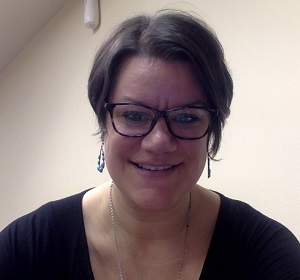February 2019 Featured Educator: Jori Ruff

Why did you choose to become an educator? How did you come to be involved with ELL teaching? Was that something you always wanted to do or was it something you acquired because of some other experiences you had? What do you love about your job? What frustrates you as an educator?
From the earliest age, I knew I wanted to work with children. In second grade, when asked what I wanted to be when I grew up, I excitedly exclaimed, “Teacher!” I began my career as a Kindergarten teacher in Eau Claire, Wisconsin. After three years as a Kindergarten teacher, I decided to pursue a dream of teaching in another country. In 2002, I moved to Guatemala and worked as a Kindergarten teacher at the American School of Guatemala in Guatemala City. My knowledge of dual language teaching and ELL education grew as I worked with students whose first language was not English. After three years of teaching in Guatemala, I returned to Wisconsin and was hired as an ELL teacher in Wisconsin Dells, my hometown. In 2007, I started teaching in the Baraboo School District and continue to do so today.
It’s difficult to pinpoint one or two things I love about my job because there are just too many. I love working with students and teachers in public education. I have a unique position in which I work with students in 4K through 5th grade in multiple schools, and since Baraboo is a smaller district, I’m able to keep in contact with many students through graduation and beyond. Having a high school student get excited when they see me in the hallway at the high school...well, is there anything better!? To know I have had some small impact on their life is incredibly humbling.
Where do you teach? What grades? How long have you been a teacher? What is your current position and how long have you been in this role?
I currently support 4-year-old Kindergarten through 5th grade ELL students in Baraboo, Wisconsin, at Al Behrman Elementary, East Elementary Schools, and the Baraboo Early Learning Cooperative. This is my 12th year in my current position as an EL Specialist. The 2018-19 school year is my 20th year as an educator.
Describe your class, school, and district. Please tell me a little about its location, size, and the composition of the student body? What do language services look like in your school?
The School District of Baraboo is located about forty miles northwest of Madison, Wisconsin, and consists of five elementary buildings, one middle school, and one high school. Additionally, our Baraboo Early Learning Cooperative (BELC) serves 4K students and their families in community-based sites. There are just over 3,000 students in our district.
At each building, approximately 5% of the student population is identified as students requiring ELL services. Language services in the buildings I serve are multifaceted. From co-planning to co-teaching to instructional coaching and providing professional development, services vary based on student needs.
What is your approach towards supporting language learning in your classroom and school? What techniques/strategies have you found to be most effective in teaching language learners?
One strategy that I have found to be effective in teaching language learners is ensuring that all educators understand the role of language learning within their level and content. It’s also important that they understand that English language acquisition is not separate from content area learning. Sharing the Can Do Descriptors with classroom teachers is an excellent way to create an asset-based perspective. Scaffolding learning with the right supports for each student, whether it be sentence frames, manipulatives, realia, or other visual/graphic supports is another strategy I use to support students.
I believe that is it important to build the capacity within content area teachers to give them the skills and strategies to support ELL students within their classroom. Our district has been training teachers in conjunction with the University of Wisconsin-Oshkosh. Teachers complete 12 graduate credits over four semesters to obtain a graduate certificate in ELL education. I believe that each child is a unique individual who needs a secure, caring, and stimulating atmosphere in which to grow and mature emotionally, intellectually, physically, and socially. My main goal as an educator is to ensure that no child’s individual demographic characteristics are a predictor of their success. I strive to help students meet their fullest potential by being a champion for them in all areas and by helping them develop a deep love and respect for themselves, others, and their environment.
How do you encourage students to learn? How do you accelerate their language development and ensure their equitable access to content learning?
As an English language learner specialist, I work to raise the achievement for all students by providing support to teachers in a coaching capacity and also through professional development. Equity in education can be defined as every student having access to the resources they need at the right moment in their education. In order to make this a reality, I have team taught with regular education classroom teachers to support the ELLs on their rosters. Team teaching allows for pre-teaching, re-teaching, bilingual support when necessary, and small group instruction. Team teaching has provided some of the most rewarding experiences of my profession. Being able to work side by side with the regular classroom teacher to provide support for not only ELLs, but also all students, results in growth and achievement for all students. Team teaching at different grade levels, providing model lessons in classrooms, and developing and presenting professional development sessions on topics such as Culturally Responsive Practices, English Language Acquisition Strategies, and SIOP are just a few of the ways in which I have supported teaching and learning.
How do you determine which language standard(s) to focus on in a lesson? Describe your planning process to address the needs of your students. How do you manage to collaborate with content area teachers?
Determining which language standards to focus on is driven by the needs of the student and also the demands of the content. Over the years, I have worked to support teachers in their understanding of content and language objectives. When co-planning, the classroom teacher and I will discuss what the content objective is and then how the student(s) will demonstrate their learning. Understanding that content learning and language learning are not separate is an important part of the discussion when co-planning. Finding time to collaborate is difficult in education; however, my administrator understands that co-planning is an essential component of supporting ELL students in the classroom and I have the ability to structure my day in order to plan weekly with teams of teachers (as needed). Email, phone calls, and brief hallway discussions are other ways in which I collaborate with teachers. Our ELL team has also created an ELL Tip of the Month that is shared with all educators which highlights strategies, ideas, and resources.
What benefits of strength do language learners bring to your classroom and school? What benefits do their families bring to schools or the surrounding community?
Language learners each have a story to tell. It is our job as educators to value and honor that story by bringing it into the classroom. Learning about students’ funds of knowledge brings more diversity into the classroom, which, hopefully, develops understanding, acceptance, and a more global worldview. When we value and learn about the uniqueness of our students and families, we create deeper connections with them, which can create greater access to learning materials and classroom activities for our students.
A welcoming environment can make a tremendous difference for all families, including ELL families. Entering a friendly, energetic atmosphere lets families know they are valued members of a school community. Valuing the culture of all of our students and families creates a school environment where everyone feels they belong and are accepted.
What methods or tools do you use to assess your students' language learning?
I assess students’ language learning using district benchmark and grade level assessment, classroom observations, formative assessment, and the ACCESS for ELLs score reports. Language learning is constantly assessed throughout the year during formal and informal meeting between classroom teachers and me. In the beginning of the year, classroom teachers receive a plan for the ELL students in their classroom that includes language goals. These goals are addressed intermittently throughout the year. As the speaking portion of ACCESS for ELLs underwent changes and increased in rigor, I wanted to ensure that oral language development was a strong focus of instruction. As an ELL team, we felt it was important to focus increasingly on the linguistic complexity required in all domains, especially speaking. For the past two years, I have focused my Student Learning Objective (SLO) on the oral language development of my ELL students. I use the WIDA Speaking Interpretive Guide to assess students’ oral language development three times throughout the year.
How has WIDA helped you achieve your goals as an educator?
As an educator, WIDA has helped me achieve my goals in various ways. By providing a plethora of resources such as the Can Do Descriptors, The Early Learning Standards, and Focus Bulletins, I am better able to support classroom teachers as we work to co-plan and co-teach ELL students. The Focus Bulletins provide an excellent resource for all educators and help me reflect on areas in which our district/school may need professional development. The professional learning I have experienced through WIDA has been first rate and has strengthened my skills as an ELL educator. As a nationwide consortium, WIDA has helped to create continuity in how ELL students are assessed which can be incredibly beneficial for students who may experience changes in their educational location. I have been an ELL educator for close to fourteen years and WIDA has played an important role in growing my professional practice, strengthening my role as an advocate, and increasing my dedication to the field.
What would you have to say or what kinds of information would you leave with educators?
One of the most important things that educators can do for their students and families is to be unwavering advocates. ELL educators must be clear on the rights of ELL students and have an understanding of the policies and laws that are in place to protect students and their families. The rights of ELL students have been established through legislation and court cases and having knowledge of that legislation and case law is essential for ELL educators. WIDA can support educators in many ways in terms of ELL students and their rights. As essential as it is for educators to advocate for their students, I also believe that it is incredibly important to support students as they gain the skills and confidence to advocate for themselves as unique learners. A quote by Cesar Chavez sums up the importance of student advocacy. “Students must have initiative; they should not be mere imitators. They must learn to think and act for themselves - and be free." One of our most important jobs as educators is supporting students in finding their unique voice.





